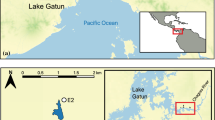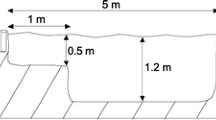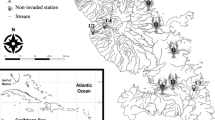Abstract
Alien predator introduction is a global threat to amphibians. Yet, there is a lack of in situ studies of trophic interactions between alien predators and native amphibians, particularly concerning small predatory fish such as mosquitofish. Mosquitofish originate from the United States but have been introduced globally, including intentionally for mosquito control. They cause declines in many amphibian populations but the mechanisms involved have been seldom investigated. Trophic interaction studies (mainly ex situ) reveal negative effects on larval amphibian stages but do not consider interactions with adults. Some site-occupancy studies show no negative association with adult amphibians, suggesting potentially complex demographic impacts and calling for a better characterization of trophic interaction with adult amphibians. Here, we studied in situ trophic interactions between introduced Eastern mosquitofish (Gambusia holbrooki) and pond-breeding palmate newts (Lissotriton helveticus; larvae and adults) using gut content and stable isotope analyses. Mosquitofish had little trophic niche overlap with adult newts. Adult newts foraged mainly on burrowing benthic macroinvertebrates that were little exploited by mosquitofish, the latter focusing mainly on microcrustaceans. Both techniques suggested predation on newt eggs or larvae and cannibalism by mosquitofish. Since native newts were still abundant despite > 50 years of mosquitofish presence and reproductively active but without evidence of larval survival, we argue that ponds invaded by small predatory fish such as mosquitofish may pose a risk by acting as demographic sinks for newts due to their predatory impact on larvae and eggs, but potentially low impact on adults in terms of trophic niche overlap.




Similar content being viewed by others
Data availability
The datasets generated and analyzed during the current study are available on request to the corresponding author.
References
Anderson MJ (2001) Permutation tests for univariate or multivariate analysis of variance and regression. Can J Fish Aquat Sci 58:626–639. https://doi.org/10.1139/cjfas-58-3-626
Anderson MJ, Gorley RN, Clarke KR (2008) PERMANOVA+ for PRIMER: a guide to software and statistical methods. PRIMER-E: Plymouth, UK
Baumgärtner D, Rothhaupt KO (2003) Predictive length–dry mass regressions for freshwater invertebrates in a pre-alpine lake littoral. Int Rev Hydrobiol 88:453–463. https://doi.org/10.1002/iroh.200310632
Benke AC, Huryn AD, Smock LA, Wallace JB (1999) Length-mass relationships for freshwater macroinvertebrates in North America with particular reference to the southeastern United States. J N Am Benthol Soc 18:308–343. https://doi.org/10.2307/1468447
Biek R, Funk WC, Maxell BA, Mills LS (2002) What is missing in amphibian decline research: insights from ecological sensitivity analysis. Cons Biol 16:728–734. https://doi.org/10.1046/j.1523-1739.2002.00433.x
Bounas A, Keroglidou M, Toli E-A, Chousidis I, Tsaparis D, Leonardos I, Sotiropoulos K (2020) Constrained by aliens, shifting landscape, or poor water quality? Factors affecting the persistence of amphibians in an urban pond network. Aquat Conserv Mar Freshw Ecosyst 30:1037–1049. https://doi.org/10.1002/aqc.3309
Brosse L, Lepage M (2000) First results on the diet of the young Atlantic sturgeon Acipenser sturio L., 1758 in the Gironde estuary. Bol Inst Español Oceanogr 16:75–80
Bucciarelli GM, Blaustein AR, Garcia TS, Kats LB (2014) Invasion complexities: the diverse impacts of nonnative species on amphibians. Copeia 2014:611–632. https://doi.org/10.1643/OT-14-014
Cabrera-Guzmán E, Díaz-Paniagua C, Gomez-Mestre I (2017) Competitive and predatory interactions between invasive mosquitofish and native larval newts. Biol Invasions 19:1449–1460. https://doi.org/10.1007/s10530-017-1369-5
Cabrera-Guzmán E, Díaz-Paniagua C, Gomez-Mestre I (2019) Invasive mosquitofish (Gambusia holbrooki) affect egg-laying and behaviour of Spanish pygmy newts (Triturus pygmaeus). Amphib Reptil 40:103–112. https://doi.org/10.1163/15685381-20181019
Clarke KR (1993) Non-parametric multivariate analyses of changes in community structure. Aust J Ecol 18:117–143. https://doi.org/10.1111/j.1442-9993.1993.tb00438.x
Clarke KR, Gorley RN (2006) PRIMER v6: User Manual/Tutorial (Plymouth Routines in Multivariate Ecological Research). PRIMER-E, Plymouth, UK.
Cloyed CS, Newsome SD, Eason PK (2015) Trophic discrimination factors and incorporation rates of carbon- and nitrogen-stable isotopes in adult green frogs, Lithobates clamitans. Physiol Biochem Zool 88:576–585. https://doi.org/10.1086/682576
Cohen JE, Pimm SL, Yodzis P, Saldaña J (1993) Body sizes of animal predators and animal prey in food webs. J Anim Ecol 62:67–78. https://doi.org/10.2307/5483
Coplen TB (2011) Guidelines and recommended terms for expression of stable-isotope-ratio and gas-ratio measurement results. Rapid Commun Mass Sp 25:2538–2560. https://doi.org/10.1002/rcm.5129
Cox JG, Lima SL (2006) Naiveté and an aquatic-terrestrial dichotomy in the effects of introduced predators. Trends Ecol Evol 21:674–680. https://doi.org/10.1016/j.tree.2006.07.011
Denoël M (2007) Le Triton palmé, Triturus helveticus (Razoumowski, 1789). In: Jacob JP, Percsy C, De Wavrin H et al (eds) Amphibiens et Reptiles de Wallonie. Aves-Raînne & Région wallonne, Namur, pp 86–95
Denoël M, Ficetola GF (2014) Heterochrony in a complex world: disentangling environmental processes of facultative paedomorphosis in an amphibian. J Anim Ecol 83:606–615
Denoël M, Winandy L (2015) The importance of phenotypic diversity in conservation: resilience of palmate newt morphotypes after fish removal in Larzac ponds (France). Biol Conserv 192:402–408. https://doi.org/10.1016/j.biocon.2015.10.018
Denoël M, Džukić G, Kalezić ML (2005) Effects of widespread fish introductions on paedomorphic newts in Europe. Conserv Biol 19:162–170. https://doi.org/10.1111/j.1523-1739.2005.00001.x
Denoël M, Ficetola GF, Sillero N, Džukić G, Kalezić ML, Vukov T, Muhovic I, Ikovic V, Lejeune B (2019) Traditionally managed landscapes do not prevent amphibian decline and the extinction of paedomorphosis. Ecol Monogr 89:e01347. https://doi.org/10.1002/ecm.1347
Dionne M (1985) Cannibalism, food availability, and reproduction in the mosquito fish (Gambusia affinis): a laboratory experiment. Am Nat 126:16–23. https://doi.org/10.1086/284392
Gabrion J, Sentein P, Gabrion C (1977) Les populations néoténiques de Triturus helveticus des Causses et du Bas-Languedoc I. Répartition et caractéristiques. La Terre La Vie 31:489–506
Galloy V, Denoël M (2010) Detrimental effect of temperature increase on the fitness of an amphibian (Lissotriton helveticus). Acta Oecol 36:179–183. https://doi.org/10.1016/j.actao.2009.12.002
Gamradt SC, Kats LB (1996) Effect of introduced crayfish and mosquitofish on California newts. Conserv Biol 10:1155–1162. https://doi.org/10.1046/j.1523-1739.1996.10041155.x
Ganihar SR (1997) Biomass estimates of terrestrial arthropods based on body length. J Biosci 22:219–224. https://doi.org/10.1007/BF02704734
Goodsell JA, Kats LB (1999) Effect of introduced mosquitofish on pacific treefrogs and the role of alternative prey. Conserv Biol 13:921–924. https://doi.org/10.1046/j.1523-1739.1999.98237.x
Gowing G, Recher HF (1984) Length-weight relationships for invertebrates from forests in south-eastern New South Wales. Aust J Ecol 9:5–8. https://doi.org/10.1111/j.1442-9993.1984.tb01612.x
Guyetant R, Pinston H, Herold JP, Rougeot JC (1991) Étude de populations de tritons: Triturus alpestris et T. helveticus dans une mare temporaire d’altitude (est de la France–Massif du Jura). In: Bagnilières JL, Castanet J, Conand F, Meunier FJ (eds) Tissus durs et âge individuel des vertébrés. ORSTIOM-INRA, pp 355–362
Hartel T, Nemes S, Cogǎlniceanu D, Öllerer K, Schweiger O, Moga CI, Demeter L (2007) The effect of fish and aquatic habitat complexity on amphibians. Hydrobiologia 583:173–182. https://doi.org/10.1007/s10750-006-0490-8
Hayden B, Soto DX, Jardine TD, Graham BS, Cunjak RA, Romakkaniemi A, Linnansaari T (2015) Small tails tell tall tales - intra-individual variation in the stable isotope values of fish fin. PLoS ONE 10:1–18. https://doi.org/10.1371/journal.pone.0145154
Howe RW, Davis GJ, Mosca V (1991) The demographic significance of ‘sink’ populations. Biol Conserv 57:239–255. https://doi.org/10.1016/0006-3207(91)90071-G
Hugueny B, Pouilly M (1999) Morphological correlates of diet in an assemblage of West African freshwater fishes. J Fish Biol 54:1310–1325. https://doi.org/10.1111/j.1095-8649.1999.tb02057.x
Jackson AL, Inger R, Parnell AC, Bearhop S (2011) Comparing isotopic niche widths among and within communities: SIBER - stable isotope Bayesian ellipses in R. J Anim Ecol 80:595–602. https://doi.org/10.1111/j.1365-2656.2011.01806.x
Jackson MC, Loewen CJG, Vinebrooke RD, Chimimba CT (2016) Net effects of multiple stressors in freshwater ecosystems: a meta-analysis. Glob Change Biol 22:180–189. https://doi.org/10.1111/gcb.13028
Joly P (1987) Le régime alimentaire des amphibiens méthodes d’étude. Alytes 6:11–17
Kiesecker JM, Blaustein AR, Miller CL (2001) Transfer of a pathogen from fish to amphibians. Conserv Biol 15:1064–1070. https://doi.org/10.1046/j.1523-1739.2001.0150041064.x
Klop-Toker K, Valdez J, Stockwell M, Clulow S, Clulow J, Mahony M (2018) Community level impacts of invasive mosquitofish may exacerbate the impact to a threatened amphibian. Austral Ecol 43:213–224. https://doi.org/10.1111/aec.12558
Knapp RA (2005) Effects of nonnative fish and habitat characteristics on lentic herpetofauna in Yosemite National Park, USA. Biol Conserv 121:265–279. https://doi.org/10.1016/j.biocon.2004.05.003
Knapp RA, Matthews KR, Sarnelle O (2001) Resistance and resilience of alpine lake fauna to fish introductions. Ecol Monogr 71:401–421. https://doi.org/10.1890/0012-9615(2001)071[0401:raroal]2.0.co;2
Komak S, Crossland MR (2000) An assessment of the introduced mosquitofish (Gambusia affinis holbrooki) as a predator of eggs, hatchlings and tadpoles of native and non-native anurans. Wildl Res 27:185–189. https://doi.org/10.1071/WR99028
Lejeune B, Sturaro N, Lepoint G, Denoël M (2018) Facultative paedomorphosis as a mechanism promoting intraspecific niche differentiation. Oikos 127:427–439. https://doi.org/10.1111/oik.04714
Lejeune B, Bissey L, Didaskalou EA, Sturaro N, Lepoint G, Denoël M (2021) Progenesis as an intrinsic factor of ecological opportunity in a polyphenic amphibian. Funct Ecol 35:546–560. https://doi.org/10.1111/1365-2435.13708
Mahony MJ, Hamer AJ, Pickett EJ, McKenzie DJ, Stockwell MP, Garnham JI, Keely CC, Deboo ML, O’Meara J, Pollard CJ, Clulow S, Lemckert FL, Bower DS, Clulow J (2013) Identifying conservation and research priorities in the face of uncertainty: a review of the threatened bell frog complex in eastern Australia. Herpetol Conserv Biol 8:519–538
McCutchan JHJ, Lewis WM, Kendall C, McGrath CC (2003) Variation in trophic shift for stable isotope ratios of carbon, nitrogen, and sulfur. Oikos 102:378–390. https://doi.org/10.1034/j.1600-0706.2003.12098.x
Miaud C (1991) La squelettochronologie chez les Triturus (amphibiens, urodèles) à partir d'une étude de T. alpestris, T. helveticus et T. cristatus du sud-est de la France. In: Bagnilières JL, Castanet J, Conand F, Meunier FJ (eds) Tissus durs et âge individuel des vertébrés. ORSTIOM-INRA, pp 363–384
Orizaola G, Braña F (2006) Effect of salmonid introduction and other environmental characteristics on amphibian distribution and abundance in mountain lakes of northern Spain. Anim Conserv 9:171–178. https://doi.org/10.1111/j.1469-1795.2006.00023.x
Pope KL (2008) Assessing changes in amphibian population dynamics following experimental manipulations of introduced fish. Conserv Biol 22:1572–1581. https://doi.org/10.1111/j.1523-1739.2008.00998.x
Prestidge RA (1979) Ingestion and assimilation efficiency of Aeshna brevistyla and Hemicordulia australiae larvae (Odonata). New Zeal J Mar Freshw Res 13:193–199. https://doi.org/10.1080/00288330.1979.9515794
Preston DL, Henderson JS, Johnson PTJ (2012) Community ecology of invasions: direct and indirect effects of multiple invasive species on aquatic communities. Ecology 93:1254–1261. https://doi.org/10.1890/11-1821.1
Pyke GH (2005) A review of the biology of Gambusia affinis and G. holbrooki. Rev Fish Biol Fish 15:339–365. https://doi.org/10.1007/s11160-006-6394-x
Pyke GH (2008) Plague minnow or mosquito fish? A review of the biology and impacts of introduced Gambusia species. Annu Rev Ecol Evol Syst 39:171–191. https://doi.org/10.1146/annurev.ecolsys.39.110707.173451
Rauchenberger M (1989) Systematics and biogeography of the genus Gambusia (Cyprinodontiformes: Poecilidae). Am Museum Novit 1–74.
Remon J, Bower DS, Gaston TF, Clulow J, Mahony MJ (2016) Stable isotope analyses reveal predation on amphibians by a globally invasive fish (Gambusia holbrooki). Aquat Conserv Mar Freshw Ecosyst 26:724–735. https://doi.org/10.1002/aqc.2631
Reynolds SJ (2009) Impact of the introduced Poeciliid Gambusia holbrooki on amphibians in southwestern Australia. Copeia 2009:296–302. https://doi.org/10.1643/CH-08-101
Richardson MJ, Whoriskey FG, Roy LH (1995) Turbidity generation and biological impacts of an exotic fish Carassius auratus, introduced into shallow seasonally anoxic ponds. J Fish Biol 47:576–585
Rolla M, Biffoni G, Brighenti S, Iacobuzio R, Liautaud K, Pasquaretta C, Tiberti R (2018) Predation by introduced fish can magnify the terrestrial arthropod subsidies in mountain lakes. Can J Fish Aquat Sci 75:1453–1464. https://doi.org/10.1139/cjfas-2017-0121
Rosen RA (1981) Length-dry weight relationships of some freshwater zooplankton. J Freshw Ecol 1:225–229. https://doi.org/10.1080/02705060.1981.9664034
Rowe DK, Smith JP, Baker C (2007) Agonistic interactions between Gambusia affinis and Galaxias maculatus: Implications for whitebait fisheries in New Zealand rivers. J Appl Ichthyol 23:668–674. https://doi.org/10.1111/j.1439-0426.2007.00912.x
Rudnick D, Resh V (2005) Stable isotopes, mesocosms and gut content analysis demonstrate trophic differences in two invasive decapod crustacea. Freshw Biol 50:1323–1336. https://doi.org/10.1111/j.1365-2427.2005.01398.x
Schumann DA, Hoback WW, Koupal KD (2015) Complex interactions between native and invasive species: Investigating the differential displacement of two topminnows native to Nebraska. Aquat Invasions 10:339–346. https://doi.org/10.3391/ai.2015.10.3.0
Shannon CE (1948) A mathematical theory of communication. Bell Syst Tech J 27:379–423. https://doi.org/10.1145/584091.584093
Smith MH, Scribner KT, Hernandez JD, Wooten MC (1989) Demographic, spatial, and temporal genetic variation in Gambusia. In: Meffe GK, Snelson FF (eds) Ecology & evolution of livebearing fishes (Poeciliidae). Prentice Hall, Englewood Cliffs, NJ, pp 235–257
Spiegelhalter DJ, Best NG, Carlin BP, Van Der Linde A (2002) Bayesian measures of model complexity and fit. J R Stat Soc Ser B Stat Methodol 64:583–616. https://doi.org/10.1111/1467-9868.00353
Stenson JAE, Aronsson S (1995) Newt-fish interactions in a small forest lake. Amphibia-Reptilia 16:177–184. https://doi.org/10.1163/156853895X00352
Stock BC, Jackson AL, Ward EJ, Parnell AC, Phillips DL, Semmens BX (2018) Analyzing mixing systems using a new generation of Bayesian tracer mixing models. PeerJ 6:e5096. https://doi.org/10.7717/peerj.5096
Stuart SN, Chanson JS, Cox NA, Young BE, Rodrigues ASL, Fischman DL, Waller RW (2004) Status and trends of amphibian declines and extinctions worldwide. Science 306:1783–1786. https://doi.org/10.1126/science.1103538
Sutton TM, Zeiber RA, Fisher BE (2013) Agonistic behavioral interactions between introduced western mosquitofish and native topminnows. J Freshw Ecol 28:1–16. https://doi.org/10.1080/02705060.2012.688492
Tiberti R, Brighenti S, Iacobuzio R, Pasquini G, Rolla M (2014) Behind the impact of introduced trout in high altitude lakes: Adult, not juvenile fish are responsible of the selective predation on crustacean zooplankton. J Limnol 73:593–597. https://doi.org/10.4081/jlimnol.2014.969
Tiberti R, Rolla M, Brighenti S, Iacobuzio R (2016) Changes in the insect emergence at the water–air interface in response to fish density manipulation in high altitude lakes. Hydrobiologia 779:93–104. https://doi.org/10.1007/s10750-016-2801-z
Tiberti R, Bogliani G, Brighenti S, Iacobuzio R, Liautaud K, Rolla M, von Hardenberg A, Bassano B (2019) Recovery of high mountain Alpine lakes after the eradication of introduced brook trout Salvelinus fontinalis using non-chemical methods. Biol Invasions 21:875–894. https://doi.org/10.1007/s10530-018-1867-0
Toli EA, Chavas C, Denoël M, Bounas A, Sotiropoulos K (2020) A subtle threat: behavioral and phenotypic consequences of invasive mosquitofish on a native paedomorphic newt. Biol Invasions 22:1299–1308. https://doi.org/10.1007/s10530-019-02181-9
Vannini A, Bruni G, Ricciardi G, Platania L, Mori E, Tricarico E (2018) Gambusia holbrooki, the ‘tadpolefish’: the impact of its predatory behaviour on four protected species of European amphibians. Aquat Conserv Mar Freshw Ecosyst 28:476–484. https://doi.org/10.1002/aqc.2880
Webb C, Joss J (1997) Does predation by the fish Gambusia holbrooki (Atheriniformes: Poeciliidae) contribute to declining frog populations? Aust Zool 30:316–324. https://doi.org/10.7882/AZ.1997.007
Whiles MR, Lips KR, Pringle CM, Kilham SS, Bixby RJ, Brenes R, Connelly S, Jose CG, Hunte-Brown M, Huryn AD, Montgomery C, Peterson S (2006) The effects of amphibian population declines on the structure and function of neotropical stream ecosystems. Front Ecol Environ 4:27–34. https://doi.org/10.1890/1540-9295(2006)004[0027:TEOAPD]2.0.CO;2
Winandy L, Denoël M (2015) The aggressive personality of an introduced fish affects foraging behavior in a polymorphic newt. Behav Ecol 26:1528–1536. https://doi.org/10.1093/beheco/arv101
Winandy L, Darnet E, Denoël M (2015) Amphibians forgo aquatic life in response to alien fish introduction. Anim Behav 109:209–216. https://doi.org/10.1016/j.anbehav.2015.08.018
Winandy L, Colin M, Denoël M (2016) Temporal habitat shift of a polymorphic newt species under predation risk. Behav Ecol 27:1025–1032. https://doi.org/10.1093/beheco/arw008
Woodford DJ, Mcintosh AR (2010) Evidence of source-sink metapopulations in a vulnerable native galaxiid fish driven by introduced trout. Ecol Appl 20:967–977. https://doi.org/10.1890/08-1909.1
Wooten MC, Scribner KT, Smith MH (1988) Genetic variability and systematics of Gambusia in the southeastern United States. Copeia 2:283–289. https://doi.org/10.2307/1445867
Acknowledgements
We are grateful to V. Cagnati, L. Fieschi-Meric and L. Prats for field help and to the pond owner for providing access to his pond. We thank the two anonymous reviewers for their constructive comments. M. Denoël and G. Lepoint are, respectively, a Research Director and a Senior Research Associate of the F.R.S.—FNRS. B. Lejeune was a PhD student funded by Fonds pour la Formation à la Recherche dans l’Industrie et dans l’Agriculture (FRIA). The capture permit of newts was issued by Direction Générale de l’Environnement, de l’Aménagement et du Logement Languedoc Roussillon. All manipulations followed ethical standards. The ethical aspects of the protocol were approved by the Conseil National de la Conservation de la Nature (France).
Funding
This research benefited from F.R.S.-FNRS (Fonds de la Recherche scientifique) grants J.0008.13, J.0112.16, and T.0070.19 and a Fonds Spéciaux pour la Recherche grant C15/63 (Univ. of Liège) to M. Denoël.
Author information
Authors and Affiliations
Contributions
MD, GL and BL contributed to the study conception and design, and supervised lab and field work. BL performed data collection, sample preparation, processing and analysis of stable isotopes and gut contents. VC and TN performed gut content analyses. The first draft of the manuscript was written by BL. MD and GL revised subsequent drafts. All authors read and approved the final manuscript.
Corresponding author
Ethics declarations
Conflict of interest
The authors have no relevant financial or non-financial interests to disclose.
Additional information
Publisher's Note
Springer Nature remains neutral with regard to jurisdictional claims in published maps and institutional affiliations.
Supplementary Information
Below is the link to the electronic supplementary material.
Rights and permissions
Springer Nature or its licensor (e.g. a society or other partner) holds exclusive rights to this article under a publishing agreement with the author(s) or other rightsholder(s); author self-archiving of the accepted manuscript version of this article is solely governed by the terms of such publishing agreement and applicable law.
About this article
Cite this article
Lejeune, B., Clément, V., Nothomb, T. et al. Trophic interactions between native newts and introduced mosquitofish suggest invaded ponds may act as demographic sinks. Biol Invasions 25, 2993–3007 (2023). https://doi.org/10.1007/s10530-023-03089-1
Received:
Accepted:
Published:
Issue Date:
DOI: https://doi.org/10.1007/s10530-023-03089-1




